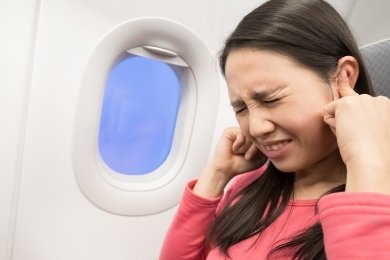Do you ever feel a sense of discomfort or ear pain when you’re flying, particularly during takeoff or landing? This discomfort is often referred to as airplane ear, a condition marked by a feeling of pressure, pain, or fullness in the ears. It occurs due to rapid changes in air pressure during flights.
Anyone flying can experience airplane ear, but it’s more common among people dealing with common cold, sinus infections, allergies, or ear infections. Young children, including infants and toddlers, are particularly prone to experiencing discomfort from airplane ear during flights.
Fortunately, there are straightforward strategies to prevent or lessen airplane ear. Simple actions like yawning, chewing gum, or swallowing can help balance the pressure in your ears. For young children, breastfeeding, using a pacifier, or drinking from a bottle or cup with a straw can provide relief.
Typically, airplane ear is a temporary condition that improves on its own after the flight, especially if preventative measures are taken.
Symptoms of Airplane Ear
Airplane ear can present a range of symptoms from mild to severe, affecting passengers’ comfort and health during flights. Understanding these symptoms can help in recognizing and addressing airplane ear promptly.
Common Symptoms
- Discomfort in the ear/s: This usually feels like an uneasy pressure or blockage in the ears, often the first sign of airplane ear.
- Pain in the ear/s: Ear pain can vary from a dull ache to a sharp, intense discomfort, signaling changes in air pressure affecting the ear.
- Fullness in the ear/s: A sensation of the ears being “full” or clogged, similar to the feeling of needing to pop your ears.
- Mild to moderate hearing loss: Temporary hearing reduction or muffling of sounds can occur, making conversations and announcements harder to understand.
Severe Symptoms
In more serious cases, the symptoms escalate beyond discomfort:
- Severe pain in the ear/s: The pain becomes hard to ignore, potentially overwhelming and significantly more intense than the common symptoms.
- Moderate to severe hearing loss: A noticeable decrease in hearing capability, which might persist longer than the flight duration.
- Tinnitus: The experience of hearing a ringing, buzzing, or hissing sound in the ears, even in the absence of external sounds.
- Vertigo: A disorienting sensation that might feel like spinning or losing one’s balance, often accompanied by nausea.
- Hemotympanum: An indication of a more severe condition, where blood is present in the middle ear, possibly resulting from significant pressure changes or injury.
Recognizing these symptoms early and taking appropriate measures can help mitigate the discomfort and potential hearing damage associated with airplane ear.
Causes of Airplane Ear
To grasp why airplane ear occurs, a basic understanding of the ear’s anatomy and its functioning at ground level is crucial.
Ear Structure
The ear is structured into three main sections:
- Outer Ear: This visible part leads to the eardrum through the external auditory canal. The eardrum acts as a boundary between the outer and middle ear.
- Middle Ear: Here, the eustachian tube connects the middle ear to the back of the nose, playing a critical role in equalizing air pressure on both sides of the eardrum.
- Inner Ear: Comprising various chambers, the inner ear is responsible for hearing and balance.
Functioning at Ground Level
Normally, air pressure is balanced between the middle ear cavity and the external environment, facilitating the ear’s normal operation.
During Flight
- Pressure Changes: As the plane ascends or descends, air pressure in the middle ear drops quickly compared to the cabin pressure, causing the eardrum to retract inward.
- Eustachian Tube Reaction: The eustachian tube may not adjust quickly enough, leading to it being flattened and causing symptoms associated with ear barotrauma.
Other Causes of Ear Barotrauma
Apart from flying, activities such as scuba diving without appropriate equipment, exposure to loud blasts, being in hyperbaric oxygen chambers, elevator rides in tall buildings, or driving in mountainous areas can lead to similar symptoms.
Individual Variability
Not everyone experiences airplane ear to the same extent due to variations in the eustachian tube’s functionality. Typically, the tube adjusts by opening during swallowing, yawning, or chewing, maintaining pressure equilibrium. However, individuals with narrower eustachian tubes or those with blockages from colds or infections are more susceptible to developing airplane ear or ear barotrauma.
Risk Factors for Airplane Ear
While pressure changes in an airplane affect everyone on board, some individuals may experience more severe ear pain than others. Several factors can influence one’s susceptibility to airplane ear, primarily by obstructing or impairing the function of the eustachian tube.
Age-Related Susceptibility
- Infants and Toddlers: Young children are particularly vulnerable to airplane ear. Their eustachian tubes are smaller and less developed, making it harder for them to equalize pressure effectively during flights.
Medical Conditions
Certain health issues can exacerbate the difficulty of adjusting to rapid pressure changes, increasing the likelihood of experiencing airplane ear:
- Common Cold: Swelling and congestion can block the eustachian tubes.
- Sinusitis: Inflammation and blockage of the sinuses can affect eustachian tube function.
- Allergic Rhinitis (Hay Fever): Allergies can lead to congestion and eustachian tube dysfunction.
- Otitis Media (Middle Ear Infection): Infections can cause fluid accumulation and blockage in the middle ear.
- Hormonal Changes: Changes during pregnancy can impact the body’s ability to adapt to pressure changes.
Sleeping During Flights
- Reduced Natural Pressure Equalization: Activities like swallowing and yawning play a critical role in balancing ear pressure. Sleeping during a flight minimizes these actions, thereby increasing the risk of developing airplane ear due to less frequent eustachian tube opening.
Understanding these risk factors can help individuals take preventative measures to minimize discomfort and protect their ear health during air travel.
Specialist To Visit
Although the discomfort of airplane ear typically subsides post-flight, certain situations warrant medical attention to prevent further complications.
Signs You Need Medical Consultation
It’s crucial to seek a doctor’s advice if you experience any of the following after flying:
- Dizziness and Unsteadiness: If you feel dizzy or as if you’re falling, especially right after a flight.
- Severe Ear Pain: Intense pain in the ear that doesn’t improve after landing.
- Ear Bleeding: Any sign of blood coming from the ear is a cause for concern.
- Fluid Drainage: Leakage of fluid from the ear, which could indicate a more serious condition.
- Hearing Difficulty: If you notice a significant reduction in your ability to hear.
Specialist Doctors for Airplane Ear
For diagnosis and treatment of airplane ear, the following specialists can provide the necessary care:
- General Physician: A primary care doctor can assess the initial symptoms and provide guidance or referrals.
- ENT Specialists: Otolaryngologists, or ENT (Ear, Nose, and Throat) specialists, have specific expertise in addressing conditions affecting the ear, including airplane ear. They can offer specialized treatments and interventions to alleviate symptoms and address any underlying issues.
Consulting the appropriate healthcare provider can ensure you receive the right care and treatment to manage and recover from airplane ear effectively.
Preventing Airplane Ear
Airplane ear can be effectively prevented with proper strategies before and during a flight. These preventative measures are categorized into primary, secondary, and tertiary strategies, each designed to address different stages of discomfort and risk.
A. Primary PreventionPrimary prevention focuses on actions taken before or during the onset of ear discomfort to prevent airplane ear.
- Practice Self-Care Measures: Engage in yawning, chewing, and swallowing during takeoff and landing. These actions help keep the eustachian tubes open.
- Sucking Lozenges and Chewing Gum: These are simple yet effective ways to stimulate swallowing and keep your ears clear as the plane ascends or descends.
- Stay Awake: Avoid sleeping during critical times of ascent and descent when pressure changes are most pronounced. If necessary, ask flight attendants to wake you before landing.
- Use of Air Pressure Regulating Earplugs: Specialized earplugs available at airports or pharmacies can help balance the pressure against the eardrum.
- Take Medications: Decongestants taken an hour before flight can ease congestion for those with colds. Always consult a healthcare provider before use, especially if you have pre-existing health conditions.
- Use Over-The-Counter (OTC) Nasal Sprays: Applying nasal spray 30 minutes before takeoff can reduce nasal congestion, decreasing the risk of airplane ear.
- Blow a Special Autoinflation Balloon: Designed for pressure equalization, these balloons can be used before, during, or after a flight to alleviate discomfort.
- Reschedule Air Travel: If you’re currently suffering from conditions like a cold or sinusitis, consider postponing your flight to avoid exacerbating airplane ear.
B. Secondary Prevention
These strategies are aimed at minimizing severe ear pain if discomfort arises.
- Valsalva Manoeuvre: This technique helps equalize middle ear pressure. Close your mouth and nose and gently exhale, holding the breath for a few seconds before releasing.
- Ear Packing: In cases of ear bleeding, immediate packing of the ear by a professional can prevent further complications.
C. Tertiary Prevention
Long-term preventive measures for frequent flyers prone to severe airplane ear.
- Surgical Intervention: The insertion of a tube into the eardrums can facilitate fluid drainage and equalize ear pressure, recommended for those frequently affected.
Special Tips for Infants and Toddlers
Young children’s susceptibility due to smaller eustachian tubes requires additional measures:
- Breastfeeding or Bottle Feeding: Helps in swallowing and pressure equalization.
- Sucking a Pacifier: Can provide similar benefits to feeding.
- Drinking from a Sipper or Straw: Encourages continuous swallowing, helping keep the eustachian tubes open.
Children older than 4 years can benefit from chewing gum or blowing bubbles through a straw to facilitate ear pressure equalization.
These comprehensive strategies can significantly reduce the risk and discomfort of airplane ear, ensuring a more comfortable flight experience for all passengers.
Treatment of Airplane Ear
How many days can an airplane ear last?
The duration of airplane ear can vary depending on individual circumstances and whether any treatment or preventive measures are taken. Typically, the symptoms of airplane ear start to improve within a few hours to a couple of days after the flight. However, in cases where the condition is more severe or if complications arise (such as an infection), symptoms could last longer, potentially up to a week or more.
If symptoms persist beyond a few days or worsen, it’s advisable to consult a healthcare provider to ensure there isn’t a more serious underlying issue needing attention. In most instances, with proper management and care, individuals can expect a swift recovery from the symptoms of airplane ear.
Which seat is ear friendly in flight?
The experience of airplane ear is primarily influenced by changes in cabin pressure during takeoff and landing, rather than by the location of your seat on the airplane. However, some passengers find that sitting in certain parts of the plane can help mitigate discomfort:
- Middle of the Plane: Seats located towards the middle of the plane, close to the wings, are often considered more stable with less perceived motion. This stability might slightly alleviate the discomfort associated with pressure changes for some passengers.
- Window Seats: Choosing a window seat can help if you plan to lean against the side of the plane for more comfortable sleep. Staying awake and actively swallowing and yawning during ascent and descent is key to preventing airplane ear, but if you need to rest, being able to lean against the window might help you sleep in a position that encourages natural swallowing.
- Avoiding Extreme Front or Back: The very front or back of the plane can sometimes experience more noise and vibration, which might indirectly affect your comfort level and your ability to manage pressure changes effectively.
It’s important to note that these seat preferences can vary from person to person and might not have a significant impact on preventing airplane ear for everyone. The most effective way to prevent airplane ear is through active pressure equalization techniques (such as yawning, swallowing, using nasal sprays, or wearing pressure-regulating earplugs) regardless of where you’re seated on the plane.
What are the ways to reduce ear pain from air travel after returning home?
If you’re experiencing ear pain from air travel after returning home, there are several effective strategies you can employ to alleviate the discomfort and facilitate recovery. Here’s what you can do:
1. Continue Pressure Equalization Techniques
- Yawning and Swallowing: These actions help open the eustachian tubes, allowing the pressure in your ears to equalize.
- Chewing Gum: Keeps you swallowing more often, which helps to balance ear pressure.
- Valsalva Maneuver: Gently exhale while pinching your nose and keeping your mouth closed to help equalize ear pressure.
2. Use Warm Compresses
- Apply a warm compress to the affected ear to help relieve pain and reduce any congestion.
3. Stay Hydrated
- Drinking plenty of fluids can help thin mucus, potentially easing eustachian tube function.
4. Nasal Decongestants or Sprays
- Over-the-counter nasal decongestants or sprays can reduce nasal congestion, making it easier for your eustachian tubes to open. Always follow the product’s instructions and consider consulting with a healthcare provider before use, especially if you have underlying health conditions.
5. Pain Relievers
- Non-prescription pain relievers such as ibuprofen or acetaminophen can help manage ear pain. Make sure to follow the dosage instructions and consult with a healthcare provider if you have any health concerns.
6. Avoid Sleeping During Descent on Future Flights
- If you have upcoming flights, try to stay awake during descent so you can actively employ pressure equalization techniques.
7. Autoinflation
- Blowing gently against closed nostrils can sometimes help to open up the eustachian tubes and equalize pressure. This should be done with caution and not excessively.
8. Consult a Healthcare Provider
- If your symptoms persist or if you experience severe pain, hearing loss, dizziness, or discharge from the ear, it’s important to see a healthcare professional. They may recommend further treatments such as prescription medications or, in rare cases, a procedure to relieve the pressure and drain any fluid.
Implementing these strategies should help alleviate ear pain from air travel. However, recovery time can vary from person to person. If discomfort continues or you’re concerned about your symptoms, seeking medical advice is always the best course of action.
How do you fix flying ears?
Fixing “flying ears,” or airplane ear, involves methods to equalize the pressure in your ears with the cabin pressure. Here are effective strategies to manage and alleviate the discomfort:
1. Swallow and Yawn
Swallowing and yawning help open the eustachian tubes, allowing air to flow into or out of your middle ear, thereby equalizing the pressure. Doing these actions frequently, especially during ascent and descent, can prevent or reduce the symptoms of airplane ear.
2. Use the Valsalva Maneuver
- Pinch your nostrils shut, take a deep breath, and then gently exhale while keeping your mouth closed and pinching your nose. This can force air back into the Eustachian tube, equalizing the pressure. Be gentle to avoid damaging your eardrums.
3. Chew Gum or Suck on Hard Candy
Chewing gum or sucking on hard candy can stimulate frequent swallowing, which helps open the eustachian tubes and balance ear pressure.
4. Stay Awake During Takeoff and Landing
Remaining awake during critical phases of the flight (takeoff and landing) allows you to perform the necessary actions (like swallowing and yawning) to equalize ear pressure actively.
5. Use Nasal Decongestants or Sprays
Taking a nasal decongestant about 30 minutes before takeoff or using a nasal spray can help reduce nasal congestion, making it easier for your eustachian tubes to open. Always consult with a healthcare provider before using these, especially if you have health conditions or are on other medications.
6. Wear Earplugs or Pressure-regulating Ear Devices
Special earplugs designed to slow the pressure change in your ears can be found at pharmacies or airports. These can help ease the adjustment of ear pressure to the changing cabin pressure.
7. Hydrate and Avoid Alcohol or Caffeine
Staying hydrated can help keep your mucous membranes moist, improving their function. Alcohol and caffeine can lead to dehydration, making symptoms worse.
8. Try Autoinflation
Autoinflation involves blowing gently against closed nostrils to push air through the eustachian tube. This should be done carefully and may not be suitable for everyone, especially if you have a cold or nasal congestion.
Professional Medical Treatment
If you frequently experience severe airplane ear or if your symptoms persist after your flight, consider consulting an ENT (Ear, Nose, and Throat) specialist. In rare cases, a procedure called a myringotomy might be performed to insert tubes in the ears to facilitate fluid drainage and air pressure equalization.
Implementing these strategies can significantly reduce discomfort and prevent long-term issues associated with flying ears. If symptoms continue or you experience severe pain, hearing loss, or dizziness, it’s crucial to seek medical advice.
How do you unblock your ears after a flight?
o unblock your ears after a flight, try these methods:
- Yawn or Swallow: Helps open the eustachian tubes.
- Chew Gum: Stimulates swallowing.
- Valsalva Maneuver: Gently exhale with your mouth closed and nostrils pinched to equalize ear pressure.
- Nasal Decongestants: Use before landing if possible.
- Earplugs: Specialized earplugs designed for flying can help.
- Stay Hydrated: Helps keep the mucous membranes functioning properly.





















